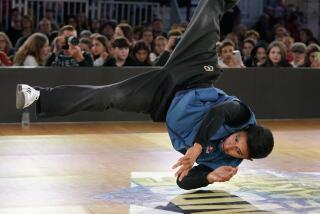A Shot Heard ‘Round the Rink
- Share via
SALT LAKE CITY — The best thing you can say about Tommy Salo taking one on the head and losing the puck in the lights (or the stars that were flashing in front of his eyes right about then) for the decisive goal in Sweden’s stunning hockey loss to Belarus is:
Good thing it wasn’t curling.
That one had to hurt. Vulcanized rubber, fired at your skull from 70 feet, with a berth in the Olympic semifinals on the line. The skull is connected to the skeleton, which is also the name of an insane new Olympic sport in which competitors luge head-first in an attempt to break records or cervical bones (whichever comes first) but rarely approaches the levels of pain foisted upon Salo Wednesday.
Say it ain’t so, Tommy Salo. The shootout shot-stopping hero of Sweden’s gold-medal run in 1994 couldn’t stop a Belarussian slapshot launched from beyond the blue line with 2:24 left in a 3-3 game. All of Sweden agonized as the puck hit Salo in the mask, then bounced over his head, then slalomed down his back and trickled over the goal line for the most mind-boggling Olympic goal since Mike Eruzione’s against the Soviet Union 22 years ago.
Belarus 4, Sweden 3.
Belarus, 0-3 in group play after being outscored, 22-6, by Russia, Finland and the United States.
Belarus, with an injury-ravaged roster filled with a bunch of guys who play for the Severstal Cherepovets, Khimik Voskresensk and Metallurg Novokuznetsk--but only one who plays in the NHL.
Belarus, overcoming so many staggering obstacles, including the Curse of the Mighty Duck, which previously held that any country with one or more current Mighty Ducks on its roster was doomed in this Olympic hockey tournament. The only NHL player of Belarus’ 25-man roster? Ruslan Salei, defenseman, Anaheim Mighty Ducks.
How is this possible?
Swedish captain Mats Sundin had no clue.
“I don’t understand how we could lose against this team,” he said.
Belarus goalie Andrei Mezin, who never made it out of the U.S. minors but managed to stop 44 shots Wednesday, had a novel suggestion:
“Sometimes even a gun without bullets shoots.”
If that isn’t the greatest quote yet uttered at these Salt Lake City Games, it’s certainly a money-saving idea biathlon might want to consider.
Sometimes even a gun without bullets shoots. And sometimes a German hockey player trying to rally his team to an upset of Belarussian proportions shoots off his mouth and shoots himself in the foot.
“We will win,” Andreas Loth guaranteed before he and his German teammates stepped onto the E Center ice against Team USA.
USA 5, Germany 0 read the scoreboard after the Germans stepped off the E Center ice.
Take a seat, Broadway Andreas.
Sometimes, silence really can be golden. Take the case of the U.S. skeleton crew. They came to Utah to exhume an old Olympic daredevil event that was tried twice previously, in 1928 and 1948, and twice shelved, presumably for safety reasons. This meant they would have to meet the press, publicize their sport, get the word out, try to explain just what in the world they must be thinking.
Instead, on the eve of skeleton’s bone-chilling return to the Winter Games, the American men clammed up. Sorry, we need to concentrate on our craft, we need to concentrate on our rafts, we’re not talking. Amazing. A skeleton media blackout. Who do they think they are, major league baseball players?
Often, it’s the other way around with skeleton, the first Olympic sport to be named for the equipment it most often breaks. Often, skeleton competitors have nothing to say to the media after they race, their broken jaws having been wired shut so they can mend.
But Jim Shea Jr. came through in grand fashion for the Americans, sledding his way past the Austrians and the Swiss for the men’s skeleton gold and stepping to the top of the medals podium 70 years after his grandfather Jack Shea, a double gold medalist in speedskating, had. Tristan Gale won the women’s competition, giving the United States a skeleton sweep.
Then, at last, Shea decided he had something to say, which said a lot about the sport of skeleton.
Asked about his state of mind before the race, Shea said, “I sort of wanted to rip someone’s head off, but I needed to calm down and relax.”
Asked to describe the thrill, for immediate lack of a better word, of skeleton, Shea said, “If bobsleigh is the champagne of thrills, then skeleton is the moonshine of thrills.”
And short-track speedskating is the 3.2% beer of thrills. Looks enticing, looks exciting, but, more times than not, leaves you feeling vaguely unsatisfied.
Chart U.S. short-tracker Apolo Anton Ohno’s Olympics so far.
Saturday in the men’s 1,000-meter final, Ohno makes his move during the last lap, he and three other racers wipe out 50 yards from the finish, allowing the last and only man standing, Australia’s Steven Bradbury, to glide home for the gold.
Wednesday in the men’s 1,500 final, Ohno makes his move down the stretch, Korea’s Kim Dong-Sung blocks the passing lane, Ohno theatrically pulls back and holds both hands up--Infraction alert! Infraction alert!--and crosses the finish behind Kim, who is promptly disqualified.
Gold medal to Ohno, who, despite six stitches in his left leg, despite crossing the finish line second, apparently cannot be stopped.
“We should use a rifle on Ohno,” fourth-place finisher Fabio Carta of Italy quipped.
Or just sic the Belarussians on him. Sometimes even a gun without bullets shoots.
More to Read
Go beyond the scoreboard
Get the latest on L.A.'s teams in the daily Sports Report newsletter.
You may occasionally receive promotional content from the Los Angeles Times.






